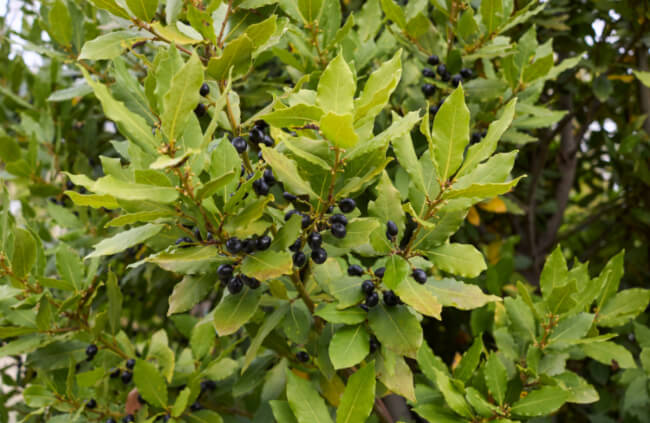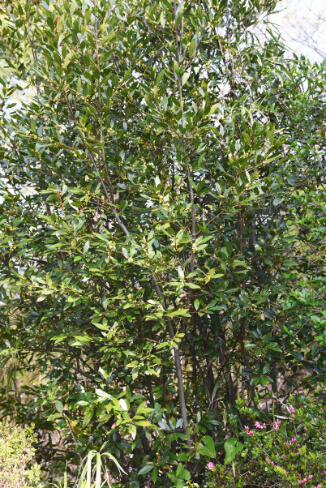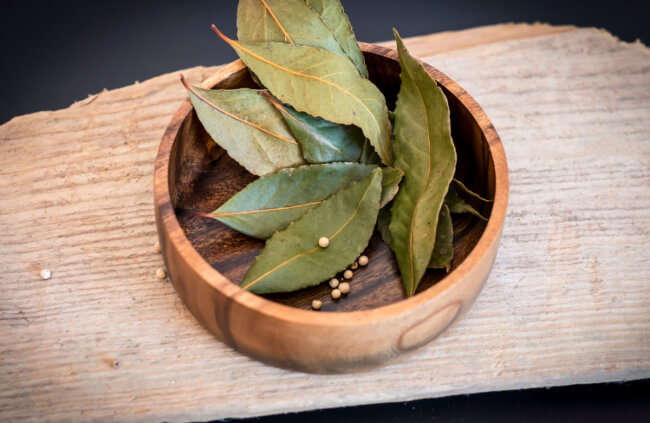If your home is in an area known for sea spray and salty conditions on the coast, a bay leaf tree would be a welcome addition. They love these kinds of conditions if they have enough shelter.
Our bay tree guide features the varieties of this evergreen shrub, which can also be a small tree. Learn how to propagate your own with ease, and enjoy this Mediterranean and Middle Eastern native in your own garden. We’ve got care advice, and a section all about the culinary use of the bay leaf.
More...

Family: | Lauraceae |
|---|---|
Genus: | Laurus |
Species: | L. nobilis |
Origin: | Mediterranean and Middle East |
Common Names: | Bay laurel, laurel tree, bay tree, bay leaf |
Location: | Indoor and outdoor |
Type: | Evergreen shrub or small tree |
Growth: | Up to 18 metres tall and 6 metres wide |
Sun requirements: | Full or partial sun |
Foliage Colour: | Green |
Flower Colour: | Yellow |
Flowering: | Spring and summer |
Fruits: | Small and shiny black berry, can be eaten raw when ripe |
Maintenance level: | Low maintenance |
Poisonous for pets: | Yes |
Introducing the Bay Leaf Tree
The Latin name for the Laurus nobilis comes from the Celtic word for green which is “laur”, and the word “nobilis” means noble. The plant produces small flowers in spring that are a green to yellow colour and after these come black berries at the end of summer.
The bay tree is quite hardy but if your area gets severe cold weather, the young trees will need some protection until they’ve had a chance to become established. For areas that are cool or warm, you can grow your bay leaf tree in full sun.
If you live somewhere with a hot and dry climate, make sure your bay tree gets some shade during the day.

Bay Leaf Varieties
If you are wanting to grow a bay leaf tree, make sure it’s Laurus nobilis, especially if you plan to use the leaves for eating and cooking. There are other types of plants that are known as bay and sweet bay, but these are not the same as Laurus nobilis.
These other kinds are not always edible and some are toxic.
If you are looking for a true bay laurel cultivar, here is a guideline:
- Laurus nobilis f. angustifolia – you might also hear this cultivar referred to as the willow leaf laurel. It has narrow leaves with an amazing texture.
- Laurus nobilis ‘Aurea’ – this cultivar produces new leaves which are bright yellow and aromatic.
- Laurus nobilis ‘Undulata’ – the leaf edges of this cultivar have a ripple effect which makes it a popular choice as an ornamental plant.
- Laurus nobilis ‘Saratoga’ – this is a smaller cultivar, with rounded leaves and a light colour.
How to Grow Bay Leaf Tree in Australia
Laurus nobilis will happily grow in a variety of soils, anything from very acidic to just a bit alkaline. Ideally provide the plant with a fertile soil that is also well-draining.
If you choose not to prune your tree, the bay tree can reach a height of up to 18 metres, but it does grow slowly. Levels of rainfall and the climate will determine the ultimate growth.
Propagating Bay Leaf Trees

How to Propagate Bay Laurel from Cuttings
You can take softwood cuttings during summer. Each cutting should be around 15 cm and it should be green and flexible. Prepare small pots or containers with coarse and moist sand or you could use a potting mix with some perlite and coco coir added.
Dip the end of the cuttings in rooting hormone before planting into the pots. You should also take off most of the leaves and just leave two or three at the top. If these leaves are quite big, you can remove a third of each leaf.
Create a hole in the planting mix and place the cutting so that half the stem is covered. Push down the soil around the cutting to help it stay upright. You can water the soil generously and make sure the soil stays moist while the cuttings are growing roots.
Place plastic bags over the pots and keep them in place with a rubber band or anything else suitable. The cuttings need to be in a warm spot that gets bright and indirect light. For the first 4 weeks you can leave the plastic bag untouched.


Get Your Free Guide:
Master Growing Australian Natives eBook
A Must Have Complete Guide for Every Australian Garden
Get Your Free Guide:
Master Growing Australian Natives eBook
A Must Have Complete Guide for Every Australian Garden
For the next couple of weeks that follow, take the bag off for an hour per day. You can then increase the amount of time the bag is taken off at a time as the weeks continue.
You should see evidence of roots in about 2 months and you can test this by gently pulling on the cuttings. If you can feel resistance, you know you’ve got roots.
You can now take the plastic bags off the pots and let the cuttings continue growing until they move on to a bigger pot or into the garden.
Bay Tree Propagating from Seeds
Only the female plants of the bay leaf tree will produce flowers and then the small fruit which contains the seed for planting.
Start off by soaking the seeds in warm water for 24 hours. This helps the germination process. Fill a container with a seed starting mixture, spread out the seeds, and then push them down lightly into the mixture.
Put the container in an area that gets at least 8 hours of sunlight per day and try to maintain a temperature around 21°C. You can mist the soil to help keep the planting mixture moist until the seeds germinate and this can take up to 6 months.
Once the seeds sprout, you should wait for the sign of their first leaves before they are transplanted. Since Laurus nobilis grows slowly, it might take some time.
Transplanting Your Bay Leaf Tree
You can aim to do your transplanting during autumn. We recommend hardening them off slowly over a couple of weeks. Start by putting the bay leaf cuttings outdoors for half an hour somewhere that is sheltered with indirect light.
Each day you can then add an hour and build up to a total of 7 hours in a day in indirect light. Once this process is complete, repeat the same exercise, but this time, place the bay laurel cuttings in direct sunlight.
You want the plants to be used to full sun before they move outdoors to the garden or are transplanted into a new pot. If you plan to grow your bay tree in a pot, make sure you choose one that is large enough to support growth and use a potting mix that is fertile and well-draining.
Best Conditions for Planting Bay Leaf

Light
For bay leaf trees that are grown inside, they need to be close to a window that gets good sun, especially during winter. The bay tree does not like a draft or too much heat from home appliances or air conditioning systems.
If your bay laurel is growing outside, it should ideally be in part shade but can handle full sun if necessary. If your area is known for a summer that is dry and hot, the plant will do well with some afternoon shade.
What Soil to Use
Laurus nobilis can grow in a range of soils – loam, sand or clay. It needs to be well-draining and can handle acid or alkaline conditions. If you’re growing bay laurel in a pot, you can use a normal potting mix.
Watering Needs
The roots of the bay tree are shallow. That means if the weather is dry, it will need water more often. You can give the bay leaf tree water often enough to keep the soil moist. The soil should be able to dry out slightly between watering but should never dry out entirely.
Temperature and Humidity
If you live in a cold area, we recommend bringing your bay laurel inside during winter time. It needs to stay cool but needs bright light. The bay tree needs a fair amount of humidity.
If you notice it dropping some leaves, you can give the plant a misting as often as possible.
Fertiliser
The bay leaf tree grows slowly and doesn’t need much feeding if it lives outdoors. In the case of a bay laurel grown in a pot, you will need to feed it during spring with a balanced organic fertiliser.
Fish emulsion and kelp is a good choice. You can also freshen up the top layers of soil during spring.
Pruning Bay Leaf Tree
If your bay leaf tree isn’t pruned, it can grow to an impressive height but in the case of plants grown in pots and pruned often, they will remain smaller. The best time to prune your bay tree is at the end of winter or beginning of spring before you see any new growth.
You want to avoid pruning during the active growing phase. It’s up to you how much you want to prune your bay leaf tree – you can decide on the size or if you want to create a specific shape.
Bay Leaf Culinary Uses
The bay leaf offers fragrance and flavour to dishes and is often used in sauces and soups. Depending on what other flavours it’s combined with, you might not be able to detect the bay leaf in particular.
It provides a subtle but important component in terms of taste. The bay leaf is sometimes used in sweeter dishes too. Bay leaves have established themselves well globally as a seasoning.
Historically, bay leaves were one of the first traded spices. It is a favourite choice in Indian, Middle Eastern, and European cooking. The flavour of the bay leaf could be best described as woody and slightly bitter. These qualities help to balance out flavours in a dish.
The French use a bunch of parsley, thyme and a bay leaf together to provide flavour and to form a stock. Marinara pasta sauce which comes originally from Naples relies on bay leaf for its famous flavour too.

Bay leaf trees grow in the wild almost everywhere in Italy so they are easily available. If you’re looking for the best bay leaves, you’ll need to head to Turkey where the bay leaf is used generously by chefs.
What’s great about the bay leaf as a herb, is that it doesn’t lose any flavour when you dry it. The herb is allowed to do its best work when it has time to simmer in a dish and goes really well with tomato, meat and potato dishes.
Roast chicken with bay leaves is simply delicious. For cream based or cheese sauces, a bay leaf adds wonderful flavour, and works just as well for a salad dressing. You can even use this herb for flavour when baking bread.
Bay laurel is popularly used dry or ground as an alternative to salt. The bay leaf can be used dry or fresh, but the fresh leaves are more bitter. Bay leaves that are dried can last for about a year in storage.
When to Harvest Bay Leaf
When it comes to harvesting bay laurel, you can pick mature leaves anytime you need them. The plant should be no less than 2 years of age before you start harvesting. Once you’ve picked your bay leaves, they can be cured on parchment paper in a warm and dry spot for 2 weeks.
Check out our list below for popular herbs you can easily grow in your garden:
Possible Pests and Diseases to Look Out For
Laurus nobilis doesn’t have any major pests and diseases to worry about. Usually if there is a problem with the tree, it’s due to overwatering and being exposed to cold and windy weather. These could make them susceptible to fungal diseases.
Anthracnose
Anthracnose is a disease that turns the leaf tips brown or black. You’ll need to prune off infected leaves and apply a fungicide to the soil. If the infection is severe, get rid of the entire plant.
Powdery mildew
This fungus leaves white ‘powder’ on the leaves of the tree. You can treat with neem oil or any horticultural oil, but we also recommend making sure there is sufficient air circulation and keeping the surface of the soil free from any debris.
You can replace the top 5 cm of the soil annually as a preventative measure to stop any fungal spores from spreading.
Phytophthora root rot
This is probably the fungal disease that the bay laurel is most vulnerable to. It works very slowly, and in advanced stages, causes the entire tree or plant to die. Look out for dark and gum like marks on the bark which is usually an early sign of the disease.
You can treat with an appropriate fungicide and replace the top few centimetres of soil to help prevent spread.
Scale
Check the leaves and stems of your bay leaf tree for scale. They like plants that are well sheltered. If you notice a fair amount of ants, this could be a giveaway that scale is at work.
Scale secretes a honeydew substance which attracts the ants. You could use a mineral oil to spray your plant twice per year to help keep infestations under control. Mealybugs and spider mites can be managed in the same way.
Spotted leaves
Spots on your Laurus nobilis usually means the roots are waterlogged or this could happen if the weather has been particularly wet. If you’re growing your bay tree in a pot, it might be that the potting soil needs some refreshing.
Bay Leaf Tree Frequently Asked Questions

What is the history of the bay leaf tree?
The history of the bay tree is deeply rooted in Greek, Roman and Chinese culture, and also that of the Bible. The biblical reference to the bay leaf is to signify prosperity and fame.
In the Christian faith, the plant is symbolic of the resurrection of Christ. In Chinese folklore, there is said to be a great bay laurel tree on the moon, with the Chinese name for the tree meaning ‘moon laurel’.
The Greeks know the bay leaf tree as Daphne. The story around this name speaks of a nymph called Daphne who asked for help from mother earth to escape the interest of Apollo. Ancient mythology tells how mother earth responded to this request by changing Daphne into a bay laurel tree to protect her.
Apollo was heartbroken and decided to wear a laurel wreath to remember her. Zeus agreed to do the same and insisted that the bay laurel tree become a standard for all celebratory occasions.
What are the health benefits of the bay tree?
Laurus nobilis has some great health benefits. It’s used to detoxify the body, promote healing of wounds, slow ageing, offer protection from bacterial infections, and aid digestion, just to name a few.
The leaves of the bay tree contain a phytonutrient which calms inflammation quickly when applied to the skin and is therefore used for arthritis and rheumatism treatments.
Bay laurel has a soothing effect and can reduce stress hormones. Its oil is combined with olive oil to make something called Aleppo soap. This soap is known all over the world for incredible skin care.
How long can a bay laurel plant live?
These trees are known to live up to 50 years and sometimes even longer.
Why does my Laurus nobilis have leaf drop?
This can sometimes happen if you’ve moved the plant from outdoors to indoors. If you also see spots on the leaves, it might mean the plant has a fungus.
The bark of my bay leaf tree is peeling. What does this mean?
Usually if a bay laurel has cracked or peeling bark, it means there has been a big and sudden change in temperature or moisture levels. If the tree looks like it’s growing as normal, you don’t need to do anything.
If you see that any area above the affected bark is not growing, you can then prune off the dead bits until you see green underneath the bark.
Why does my bay leaf tree have yellow / brown leaves?
If you notice yellow leaves, this usually means the bay leaf is getting too much water. In the case of brown leaves, the plant isn’t getting sufficient water.
Sign up for our newsletter for more gardening tips and inspiration.
Add Bay Leaf Tree to Your List of Easy to Access Herbs in Your Garden
The bay tree is loved for gardens because it’s equally happy growing in a pot or in a garden bed. You can be diligent about pruning it into some lovely topiary shapes if that’s your garden inspiration since the bay leaf is happy to be pruned. You can even grow your bay leaf tree in a relatively small garden or on your balcony.
Published on June 21, 2023 by Gary Clarke
Last Updated on September 19, 2024




